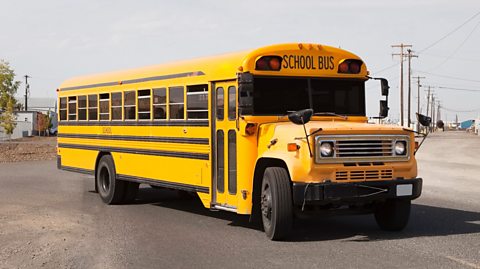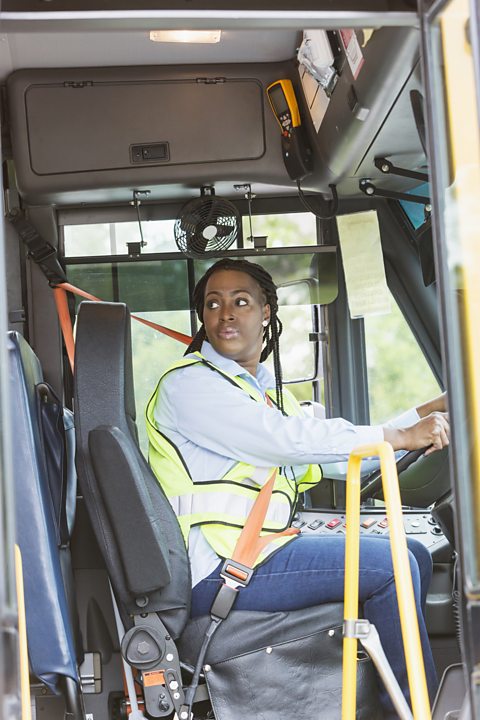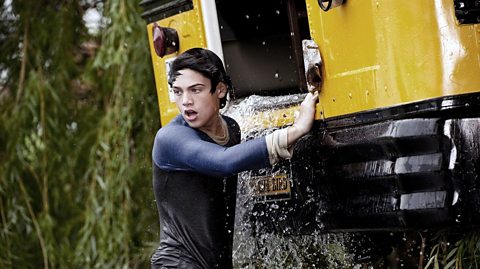We all have those moments to cherish from our earliest days in school.
It could be choosing the peg to hang your coat on, meeting your teacher for the first time, or your first trip to the canteen.
And if you grew up in the USA, those memories have a good chance of involving a form of transport millions of children there take every day to lessons. The yellow school bus is such a big part of life in the United States, even if you have never visited the country, you've probably seen it featured on film or TV. Here, ±«Óătv Bitesize takes a look at the symbol which plays a significant part in American school culture.
Frank Cyr: An educator with a vision
Frank Cyr was born in the midwestern state of Nebraska and spent his professional life in education. He had worked in rural areas and, after commissioning a study of 10 different states, found that some children were still travelling to school in horse-drawn wagons in the late 1930s, while others commuted in trucks and buses of various sizes.

He strongly believed that standardising the method of transport American children took to school would not only be cost-effective, in that whatever vehicle decided upon could be mass produced, but also safer, as features which put the young passengersâ welfare first would be part of each vehicle.
In 1939, Cyr attended a conference at the Teachers College of Columbia University with the aim of delegates agreeing on those standards for an American school bus. There, he hung 50 different shades of paint colour in strips on a wall. A selected group of the attendees, which included members of the bus industry, were tasked with selecting the preferred shade the buses would become. They went for an orange-yellow colour which became National School Bus Chrome, known today as National School Bus Glossy Yellow.

A very special shade of yellow
One reason the delegates may have been unknowingly drawn to this shade was explained by Ivan Schwab of the American Academy of The branch of medicine that deals with diseases of the eyes. in 2019. School bus yellow stimulates two photoreceptor cells (or âconesâ) in our eyes - most colours only stimulate one. Doubling the transmission of colour signals to our brain makes National School Bus Glossy Yellow very difficult to miss, even in a driverâs peripheral vision. What's more, the positioning of the black lettering on various parts of the vehicle stands out against the yellow to such an extent that it can still be read at darker times of day. Serious accidents involving the buses are rare.
The USA is a vast country and its infrastructure includes some major transportation fleets, including trains and planes. Figures from the New York School Bus Contractors Association show the yellow buses are its largest, with more than 480,000 in operation. They take an estimated 26m students to and from school - another estimate from the Contractors Association is that it saves families more than $7bn in fuel costs each year and from a sustainability perspective, saves almost 2.3bn gallons (almost 10.5bn litres) of fuel. Each school bus replaces 36 cars that would instead travel 3,600 miles (just over 5,793 km) each year on the school run. Yellow bus journeys can be free, although some schools may charge families for the service to reduce costs.

A regular on our screens
As well as being a big part of American life, the yellow school bus may look familiar to those of us based in the UK. One reason for this is that they often crop up in films and TV shows - such as The Simpsons - broadcast around the world.

In 1978âs Superman: The Movie, the first to star Christopher Reeve in the title role, the Kryptonian hero has to fly in to save a school bus in trouble after an earthquake hits San Franciscoâs Golden Gate Bridge. For some reason, school buses and superhero movies enjoy a steady relationship. Tom Hollandâs Spider-Man joins the action in Avengers: Infinity War after spying the spacecraft that Ebony Maw and Cull Obsidian land in New York from the window of his bus to school. In Man of Steel, a 2013 update of the Superman story, a young Clark Kent saves his fellow pupils after their bus crashes into a river.
School buses can even have a sprinkle of Hollywood magic applied to them - in 2005âs Sky High - about an academy for superheroes in the clouds - a seemingly ordinary bus sprouts wings and rocket thrusters to propel pupils to lessons.
You may also have seen TV shows where kids are picked up at their front door, taken to school, then dropped off home again afterwards. This is known as a curb[sic]-to-school service and although it does still operate, not every child is eligible. Pupils who donât qualify for this service wait at a designated stop
Each state has its own way of running a bus service, with its own regulations. For example, students in New York state who are eligible for school transport but cannot access the yellow bus service receive a pass for public transport instead.
This article was published in August 2023.
The brilliantly brutal back to school quiz
Schoolâs in for autumn â nowâs your chance to test your knowledge.

Parents Konnie Huq and Harry Judd talk bullying. collection
A collection of articles & films - Konnie and Harry talk about their experiences alongside expert tips from the Anti-Bullying Alliance.

Five of the most amazing film sets in history
How the worlds of James Bond, Lord of the Rings and Cleopatra were created in jaw-dropping scale
